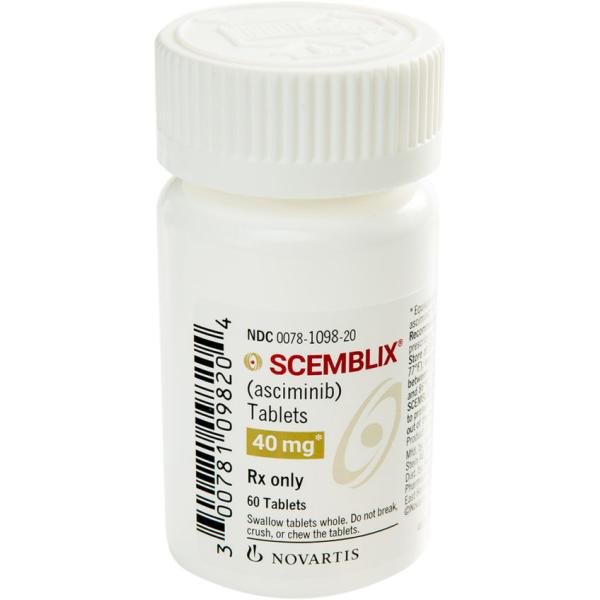Scemblix Dosage
Generic name: ASCIMINIB HYDROCHLORIDE 20mg
Dosage form: tablet, film coated
Drug class: BCR-ABL tyrosine kinase inhibitors
Medically reviewed by Drugs.com. Last updated on Nov 8, 2023.
2.1 Recommended Dosage in Patients with Ph+ CML-CP, Previously Treated with Two or More TKIs
The recommended dose of SCEMBLIX is 80 mg taken orally once daily at approximately the same time each day or 40 mg orally twice daily at approximately 12-hour intervals. The recommended dose of SCEMBLIX is taken orally without food. Avoid food consumption for at least 2 hours before and 1 hour after taking SCEMBLIX [see Clinical Pharmacology (12.2)].
Continue treatment with SCEMBLIX as long as clinical benefit is observed or until unacceptable toxicity occurs.
2.2 Recommended Dosage in Patients with Ph+ CML-CP with the T315I Mutation
The recommended dose of SCEMBLIX is 200 mg taken orally twice daily at approximately 12-hour intervals. The recommended dose of SCEMBLIX is taken orally without food. Avoid food consumption for at least 2 hours before and 1 hour after taking SCEMBLIX [see Clinical Pharmacology (12.2)].
2.3 Missed Dose
Once Daily Dosage Regimen: If a SCEMBLIX dose is missed by more than approximately 12 hours, skip the dose and take the next dose as scheduled.
Twice Daily Dosage Regimens: If a SCEMBLIX dose is missed by more than approximately 6 hours, skip the dose and take the next dose as scheduled.
2.4 Dosage Modifications
Dosage Modifications for Patients with Ph+ CML-CP, Previously Treated with Two or More TKIs
For the management of adverse reactions, reduce the SCEMBLIX dose as described in Table 1.
Dosage Modifications for Patients with Ph+ CML-CP with the T315I Mutation
For the management of adverse reactions, reduce the SCEMBLIX dose as described in Table 1.
| Dosage Reduction | Dosage for Patients with CP-CML, Previously Treated with Two or More TKIs | Dosage for Patients with Ph+ CML-CP with the T315I Mutation |
| First |
|
160 mg twice daily |
| Subsequent Reduction | Permanently discontinue SCEMBLIX in patients unable to tolerate 40 mg once daily OR 20 mg twice daily. | Permanently discontinue SCEMBLIX in patients unable to tolerate 160 mg twice daily. |
The recommended dosage modifications for the management of selected adverse reactions are shown in Table 2.
| Abbreviations: ANC, absolute neutrophil count; PLT, platelets; ULN, upper limit of normal. 1Based on Common Terminology Criteria for Adverse Events (CTCAE) version 4.03. |
|
| Adverse Reaction | Dosage Modification |
| Thrombocytopenia and/or neutropenia [see Warnings and Precautions (5.1)] | |
| ANC less than 1.0 x 109/L and/or PLT less than 50 x 109/L | Withhold SCEMBLIX until resolved to ANC greater than or equal to 1 x 109/L and/or PLT greater than or equal to 50 x 109/L. If resolved:
|
| Asymptomatic amylase and/or lipase elevation [see Warnings and Precautions (5.2)] | |
| Elevation greater than 2.0 x ULN | Withhold SCEMBLIX until resolved to less than 1.5 x ULN. If resolved:
|
| Non-hematologic adverse reactions [see Warnings and Precautions (5.3, 5.4, 5.5)] | |
| Grade 31 or higher | Withhold SCEMBLIX until recovery to Grade 1 or less. If resolved:
|
More about Scemblix (asciminib)
- Check interactions
- Compare alternatives
- Pricing & coupons
- Drug images
- Side effects
- During pregnancy
- FDA approval history
- Drug class: BCR-ABL tyrosine kinase inhibitors
- En español
Patient resources
Professional resources
Related treatment guides
Further information
Always consult your healthcare provider to ensure the information displayed on this page applies to your personal circumstances.

